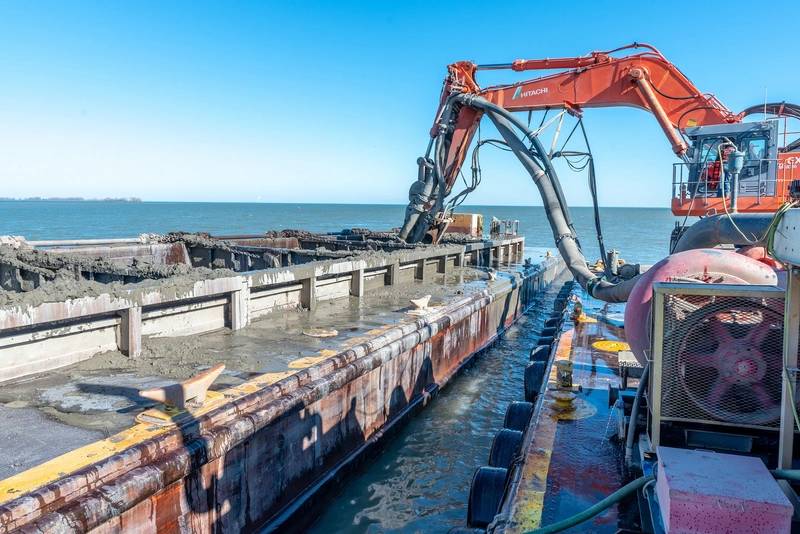New Dredged Material Guidance for the Great Lakes Region
Researchers from the U.S. Army Engineer Research and Development Center (ERDC) Environmental Laboratory and the U.S. Army Corps of Engineers (USACE) Great Lakes Districts — Buffalo, Detroit and Chicago — recently released a technical report providing guidance for evaluating the environmental suitability of dredged material in the Great Lakes region.
The “Environmental Evaluation and Management of Dredged Material for Beneficial Use: A Regional Beneficial Use Testing Manual for the Great Lakes” is the first guidance developed by USACE for evaluating the environmental suitability of dredged material specifically for beneficial use placements.

“There was a need to develop a regional approach to determining the environmental suitability of dredged material for beneficial use,” said Dr. Karen Keil, ERDC environmental toxicologist and co-chair of the Great Lakes Dredging Team (GLDT). “The publication of this technical report should make implementing beneficial use of dredged material projects more efficient and support implementation of Section 125 of the Water Resources Development Act of 2020.”
The Great Lakes region is comprised of eight states, with some harbors that overlap state boundaries, demonstrating the need for a regional approach for evaluating suitability of the beneficial use of dredged material.
Sediment is a valuable resource within the Great Lakes ecosystem, and many dredged sediments are suitable for a variety of beneficial uses. Beneficial use refers to using dredged material rather than disposing of it. In the Great Lakes region, and throughout the country, beneficial use of dredged sediment has been successful in nourishing beaches, replenishing eroding shorelines, creating habitat and restoring brownfields.
In the Great Lakes, sediments have become cleaner over time with the advent of the Clean Water Act and Great Lakes Legacy Act sediment remediations. The manual helps practitioners demonstrate that dredged material is environmentally suitable for a range of beneficial uses, including in projects involved with remediating and restoring U.S. Environmental Protection Agency (USEPA) Great Lakes Areas of Concern. Dredged sediment can be managed as a valuable resource with the potential to create economic, environmental and social benefits.
USACE has a clear set of guidelines to evaluate the suitability of dredged sediment for aquatic placements. However, prior to the publication of the manual, no USACE guidelines existed for unconfined upland beneficial use of dredged material.
“To allow upland beneficial use of dredged material, each state has its own guidance and regulations, some of which are very broad and not specifically meant for dredged material,” Keil said. “The manual provides the necessary guidance for upland placement and is consistent with environmental regulations and guidance developed by the eight Great Lakes states as well as the USEPA.”
ERDC researchers began working on the manual in 2011. In 2015, USACE Buffalo District took over as lead for its creation, working with colleagues from USACE’s Chicago and Detroit Districts, as well as ERDC.
The manual sets forth an approach that protects human health and the environment and supports projects that can restore habitats and redevelop brownfields. Approaches presented in the manual also support the goals of the GLDT, which provides a forum for the exchange of information regarding best practices, lessons learned, innovative solutions and sustainable approaches to dredging and dredge material management throughout the Great Lakes region.
“Assembling a Beneficial Use Testing Manual was likely as important to the coastal states as it is to the USACE districts,” said Dan Breneman of the Minnesota Pollution Control Agency and co-chair of the GLDT. “Within the manual, each state’s approach for managing dredge material can be reviewed, and those details then encourage innovative thinking.”
Breneman added that the publication of the manual allows for engagement among key partnership staff for a better understanding of current regulatory procedures.
A project of this scope would not have been possible without interagency coordination and cooperation. However, the project did come with hurdles to overcome.
“During the process, some of our partner agencies were hesitant to include newer scientific evaluation protocols that were not included in previously published USEPA-USACE dredged material testing manuals, while other agencies wanted USACE to include newer testing methods” said Keil. “The end product is a testament to the effective collaboration among all project partners.”
In addition to providing guidance for the Great Lake states, the publication of the manual supports the USACE’s Research and Development Strategy, specifically the “Ensure Environmental Sustainability and Resilience” priority, which, in part, directs USACE projects to “use over 70% of the sediment dredged from navigation channels for environmental benefits.”
“Because each state approaches dredge material management from different perspectives and regulatory approaches, the USACE staff, who generated this manual, should be applauded for their efforts and persistence,” Breneman said.
“This is a wonderful accomplishment that will continue to enable USACE and its partners in being good stewards of America’s natural resources,” said Dr. Edmond Russo, ERDC Environmental Laboratory director. “We are very proud of the team who made this significant achievement possible. ERDC looks forward to providing continued support to the USACE districts with a view toward delivering high-value impact that would otherwise not be possible.”
